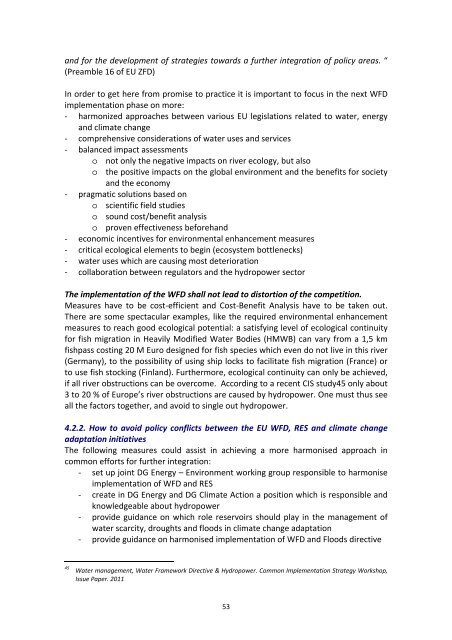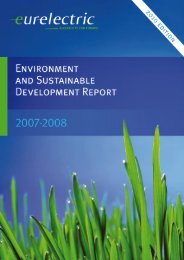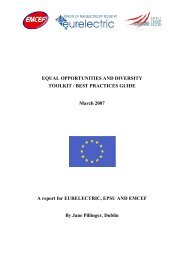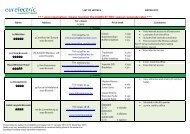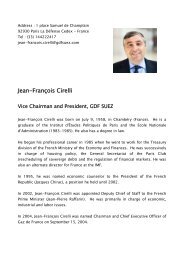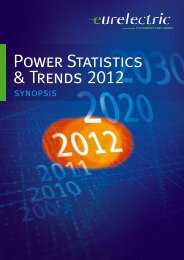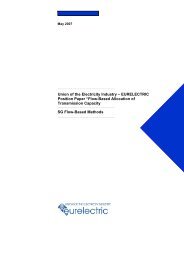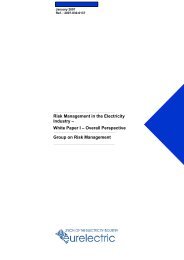Hydro in Europe: Powering Renewables - Full Report - Eurelectric
Hydro in Europe: Powering Renewables - Full Report - Eurelectric
Hydro in Europe: Powering Renewables - Full Report - Eurelectric
Create successful ePaper yourself
Turn your PDF publications into a flip-book with our unique Google optimized e-Paper software.
and for the development of strategies towards a further <strong>in</strong>tegration of policy areas. “<br />
(Preamble 16 of EU ZFD)<br />
In order to get here from promise to practice it is important to focus <strong>in</strong> the next WFD<br />
implementation phase on more:<br />
- harmonized approaches between various EU legislations related to water, energy<br />
and climate change<br />
- comprehensive considerations of water uses and services<br />
- balanced impact assessments<br />
o not only the negative impacts on river ecology, but also<br />
o the positive impacts on the global environment and the benefits for society<br />
and the economy<br />
- pragmatic solutions based on<br />
o scientific field studies<br />
o sound cost/benefit analysis<br />
o proven effectiveness beforehand<br />
- economic <strong>in</strong>centives for environmental enhancement measures<br />
- critical ecological elements to beg<strong>in</strong> (ecosystem bottlenecks)<br />
- water uses which are caus<strong>in</strong>g most deterioration<br />
- collaboration between regulators and the hydropower sector<br />
The implementation of the WFD shall not lead to distortion of the competition.<br />
Measures have to be cost-efficient and Cost-Benefit Analysis have to be taken out.<br />
There are some spectacular examples, like the required environmental enhancement<br />
measures to reach good ecological potential: a satisfy<strong>in</strong>g level of ecological cont<strong>in</strong>uity<br />
for fish migration <strong>in</strong> Heavily Modified Water Bodies (HMWB) can vary from a 1,5 km<br />
fishpass cost<strong>in</strong>g 20 M Euro designed for fish species which even do not live <strong>in</strong> this river<br />
(Germany), to the possibility of us<strong>in</strong>g ship locks to facilitate fish migration (France) or<br />
to use fish stock<strong>in</strong>g (F<strong>in</strong>land). Furthermore, ecological cont<strong>in</strong>uity can only be achieved,<br />
if all river obstructions can be overcome. Accord<strong>in</strong>g to a recent CIS study45 only about<br />
3 to 20 % of <strong>Europe</strong>’s river obstructions are caused by hydropower. One must thus see<br />
all the factors together, and avoid to s<strong>in</strong>gle out hydropower.<br />
4.2.2. How to avoid policy conflicts between the EU WFD, RES and climate change<br />
adaptation <strong>in</strong>itiatives<br />
The follow<strong>in</strong>g measures could assist <strong>in</strong> achiev<strong>in</strong>g a more harmonised approach <strong>in</strong><br />
common efforts for further <strong>in</strong>tegration:<br />
- set up jo<strong>in</strong>t DG Energy – Environment work<strong>in</strong>g group responsible to harmonise<br />
implementation of WFD and RES<br />
- create <strong>in</strong> DG Energy and DG Climate Action a position which is responsible and<br />
knowledgeable about hydropower<br />
- provide guidance on which role reservoirs should play <strong>in</strong> the management of<br />
water scarcity, droughts and floods <strong>in</strong> climate change adaptation<br />
- provide guidance on harmonised implementation of WFD and Floods directive<br />
45<br />
Water management, Water Framework Directive & <strong>Hydro</strong>power. Common Implementation Strategy Workshop,<br />
Issue Paper. 2011<br />
53


